- Joined
- Feb 2, 2011
- Messages
- 2,093
NEW RELEASES FOR DECEMBER 2022
THE EIGHTEENTH CENTURY
DRUMS ALONG THE MOHAWK
THE BATTLE OF ORISKANY, 1777
SIR JOHN JOHNSON’S, KING’S ROYAL REGIMENT OF NEW YORK
The King’s Royal Regiment of New York, also know as Johnson’s Royal Regiment of New York,King’s Royal Regiment, Kings’s Royal Yorkers and the Royal Greens, were one of the first Loyalist regiments, raised on June 19[SUP]th[/SUP] 1776, in British Canada, during the Revolutionary War.
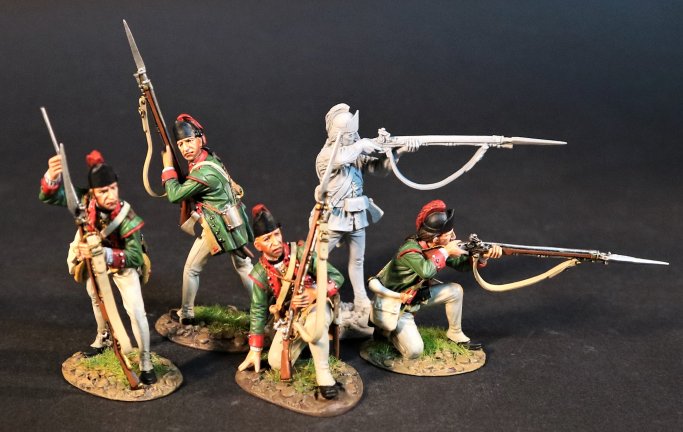
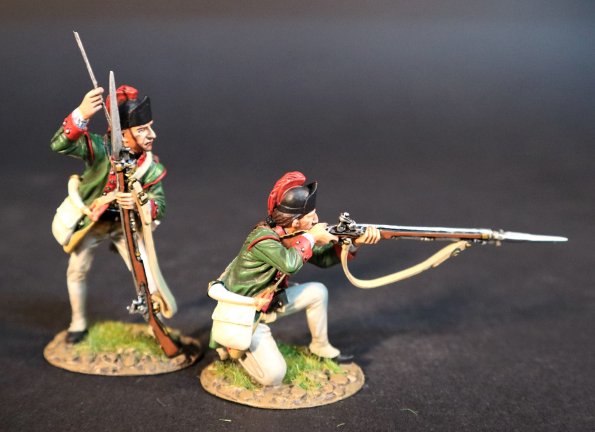
DAM-30
DRUMS ALONG THE MOHAWK,
THE BATTLE OF ORISKANY, August 6[SUP]th[/SUP] 1777,
SIR JOHN JOHNSON’S, KING’S ROYAL REGIMENT OF NEW YORK
The King’s Royal Regiment of New York was formed by exiled Loyalist leader, Sir John Johnson, from American refugees, fleeing persecution.
On 19[SUP]th[/SUP] May 1776, Sir John Johnson left his home at Johnson Hall in the Mohawk Valley and travelled with his family and approximately 200 retainers through the Adirondack Mountains to Montreal, Quebec. They arrived on the 15[SUP]th[/SUP] June, just days after Governor Sir Guy Carleton’s army recaptured the city.
Johnson soon left Montreal to chase the retreating Continental Army southwards down the Richelieu Valley towards Lake Champlain. He met Carleton at Fort Chambly where the Governor authorized Johnson to raise the King’s Royal Regiment of New York.
Initially, the members of the regiment comprised Johnson's refugee retainers from his estates in the Mohawk Valley, but the steady stream of Loyalist refugees fleeing to Montreal provided a ready source of recruits for the King's Royal Yorkers. The Regiment served with distinction throughout the war, launching raids and relief missions into the Mohawk Valley of New York.
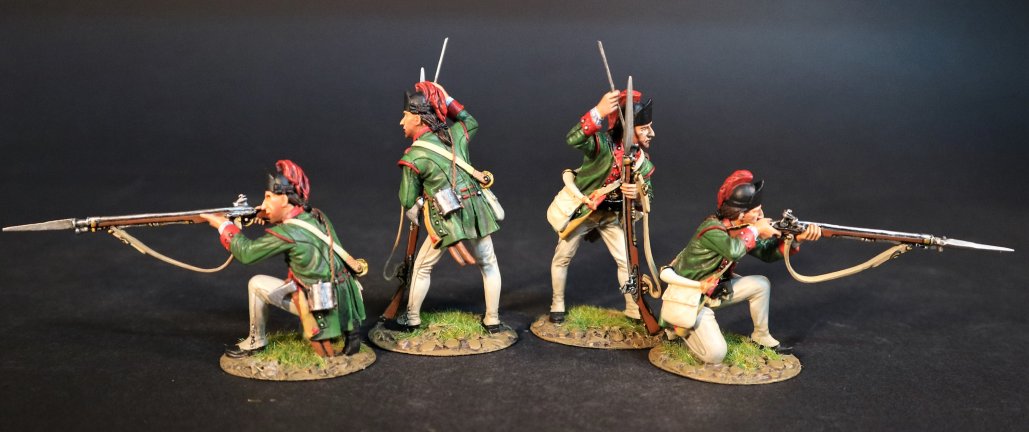
DAM-30N
DRUMS ALONG THE MOHAWK,
THE BATTLE OF ORISKANY, August 6[SUP]th[/SUP] 1777,
SIR JOHN JOHNSON’S, KING’S ROYAL REGIMENT OF NEW YORK
For the remainder of the Revolution, the King's Royal Yorkers formed an integral part of Canada's garrison. However, each year the regiment sent parties on raids into the Mohawk and neighbouring valleys for the purposes of rescuing beleaguered Loyalists and interfering with the ability of the Continental Army forces to use the region's crops as a source of food for Washington's army. These raids were generally launched from the Lake Champlain corridor or from Oswego, and caused a great deal of disruption. The militia of Northern New York never recovered from the disaster at Oriskany, and the region stood relatively defenseless.
In 1780, a large raid in to the Schoharie Valley led by Sir John Johnson gave rise to the destruction of large numbers of farms and pitched battles between the raiders and the demoralized American militia.
THE AMERICAN WAR OF INDEPENDENCE 1775 – 1783
THE BATTLE OF COWPENS, JANUARY 17[SUP]th[/SUP], 1781
THE 71[SUP]st[/SUP] REGIMENT OF FOOT
The Battle of Cowpens was an engagement during the American Revolutionary War fought on January 17[SUP]th[/SUP] 1781, near the town of Cowpens, South Carolina, between American forces under Brigadier General Daniel Morgan, and British forces under Lieutenant Colonel Banastre Tarleton, as part of the campaign in the Carolinas.
The battle was a turning point in the American reconquest of South Carolina from the British.
Tarleton’s force of 1,000 British troops were set against 2,000 troops under Morgan. Morgan’s forces suffered casualties of only 25 killed and 124 wounded. Tarleton’s force was almost completely eliminated with almost 30% casualties and 55% of his force captured or missing, with Tarleton himself and only about 200 British troops escaping.
Morgan’s forces conducted a double envelopment of the British forces, the only double envelopment of the war.
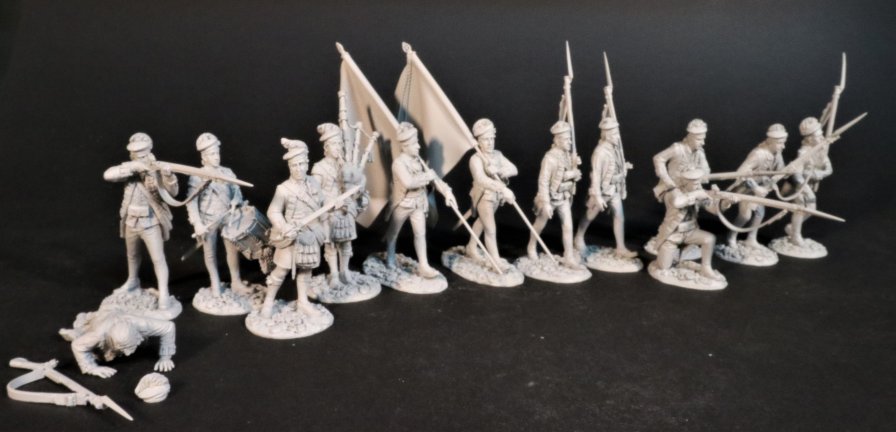
The 71[SUP]st[/SUP] Regiment of Foot was a regiment of infantry raised in 1775, and unofficially known as Fraser’s Highlanders. It was disbanded in 1786.
The regiment was raised at Inverness, Stirling and Glasgow by Lieutenant- General Simon Fraser of Lovat as the 71[SUP]st[/SUP] Regiment of Foot in 1775.
It was specifically intended for service in the American Revolutionary War.
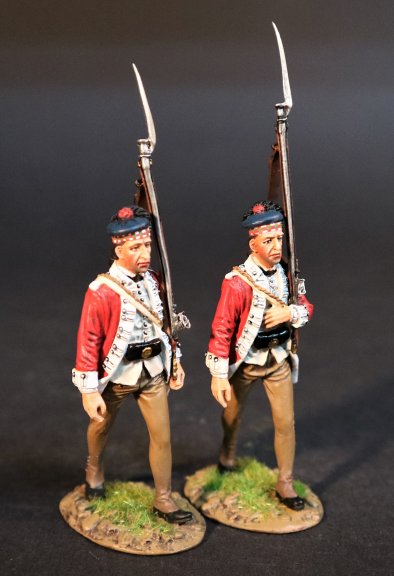
CW71-05
THE AMERICAN WAR OF INDEPENDENCE 1775 – 1783
THE BATTLE OF COWPENS, JANUARY 17[SUP]th[/SUP], 1781.
THE BRITISH ARMY,
1[SUP]st[/SUP] BATTALION, 71[SUP]st[/SUP] REGIMENT OF FOOT.
2 LINE INFANTRY
After service in the northern colonies, the regiment was sent south in December 1778. From that time forward all parts of the regiment were involved in most actions of the southern campaign. The 71[SUP]st[/SUP] was to incorporate numerous colonial recruits, though the morale of the unit as a regular regiment was high.
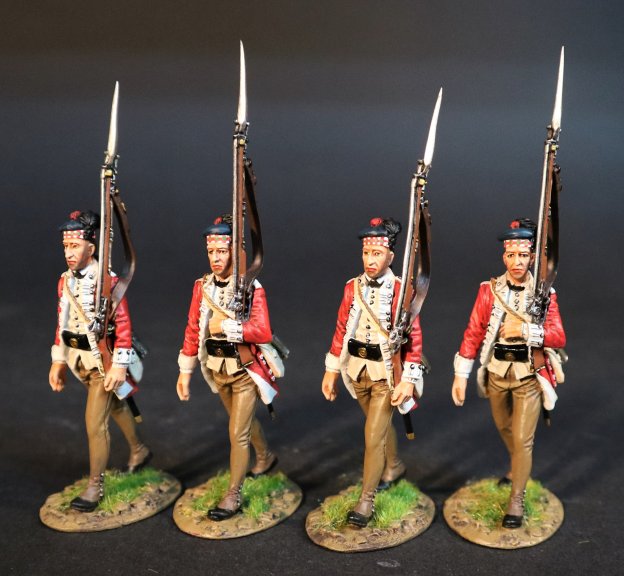
CW71-05N
THE AMERICAN WAR OF INDEPENDENCE 1775 – 1783
THE BATTLE OF COWPENS, JANUARY 17[SUP]th[/SUP], 1781.
THE BRITISH ARMY,
1[SUP]st[/SUP] BATTALION, 71[SUP]st[/SUP] REGIMENT OF FOOT.
4 LINE INFANTRY
The 1[SUP]st[/SUP] Battalion under Major Archibald McArthur was assigned to Tarleton’s command to pursue Daniel Morgan’s Flying army until the clash at Cowpens. The only men to escape the Cowpens debacle were those few left guarding the baggage train in the rear. As a result of the defeat the regiment thereafter wore no uniform facings. The officers of the 71[SUP]st[/SUP] petitioned Cornwallis that the regiment never again serve under Tarleton’s command, and Cornwallis honoured the request.
The remnants of the 71[SUP]st[/SUP] would fight on, and surrendered at Yorktown.
PLEASE CONTACT YOUR LOCAL DEALER FOR FURTHER INFORMATION
THE EIGHTEENTH CENTURY
DRUMS ALONG THE MOHAWK
THE BATTLE OF ORISKANY, 1777
SIR JOHN JOHNSON’S, KING’S ROYAL REGIMENT OF NEW YORK
The King’s Royal Regiment of New York, also know as Johnson’s Royal Regiment of New York,King’s Royal Regiment, Kings’s Royal Yorkers and the Royal Greens, were one of the first Loyalist regiments, raised on June 19[SUP]th[/SUP] 1776, in British Canada, during the Revolutionary War.


DAM-30
DRUMS ALONG THE MOHAWK,
THE BATTLE OF ORISKANY, August 6[SUP]th[/SUP] 1777,
SIR JOHN JOHNSON’S, KING’S ROYAL REGIMENT OF NEW YORK
The King’s Royal Regiment of New York was formed by exiled Loyalist leader, Sir John Johnson, from American refugees, fleeing persecution.
On 19[SUP]th[/SUP] May 1776, Sir John Johnson left his home at Johnson Hall in the Mohawk Valley and travelled with his family and approximately 200 retainers through the Adirondack Mountains to Montreal, Quebec. They arrived on the 15[SUP]th[/SUP] June, just days after Governor Sir Guy Carleton’s army recaptured the city.
Johnson soon left Montreal to chase the retreating Continental Army southwards down the Richelieu Valley towards Lake Champlain. He met Carleton at Fort Chambly where the Governor authorized Johnson to raise the King’s Royal Regiment of New York.
Initially, the members of the regiment comprised Johnson's refugee retainers from his estates in the Mohawk Valley, but the steady stream of Loyalist refugees fleeing to Montreal provided a ready source of recruits for the King's Royal Yorkers. The Regiment served with distinction throughout the war, launching raids and relief missions into the Mohawk Valley of New York.

DAM-30N
DRUMS ALONG THE MOHAWK,
THE BATTLE OF ORISKANY, August 6[SUP]th[/SUP] 1777,
SIR JOHN JOHNSON’S, KING’S ROYAL REGIMENT OF NEW YORK
For the remainder of the Revolution, the King's Royal Yorkers formed an integral part of Canada's garrison. However, each year the regiment sent parties on raids into the Mohawk and neighbouring valleys for the purposes of rescuing beleaguered Loyalists and interfering with the ability of the Continental Army forces to use the region's crops as a source of food for Washington's army. These raids were generally launched from the Lake Champlain corridor or from Oswego, and caused a great deal of disruption. The militia of Northern New York never recovered from the disaster at Oriskany, and the region stood relatively defenseless.
In 1780, a large raid in to the Schoharie Valley led by Sir John Johnson gave rise to the destruction of large numbers of farms and pitched battles between the raiders and the demoralized American militia.
THE AMERICAN WAR OF INDEPENDENCE 1775 – 1783
THE BATTLE OF COWPENS, JANUARY 17[SUP]th[/SUP], 1781
THE 71[SUP]st[/SUP] REGIMENT OF FOOT
The Battle of Cowpens was an engagement during the American Revolutionary War fought on January 17[SUP]th[/SUP] 1781, near the town of Cowpens, South Carolina, between American forces under Brigadier General Daniel Morgan, and British forces under Lieutenant Colonel Banastre Tarleton, as part of the campaign in the Carolinas.
The battle was a turning point in the American reconquest of South Carolina from the British.
Tarleton’s force of 1,000 British troops were set against 2,000 troops under Morgan. Morgan’s forces suffered casualties of only 25 killed and 124 wounded. Tarleton’s force was almost completely eliminated with almost 30% casualties and 55% of his force captured or missing, with Tarleton himself and only about 200 British troops escaping.
Morgan’s forces conducted a double envelopment of the British forces, the only double envelopment of the war.

The 71[SUP]st[/SUP] Regiment of Foot was a regiment of infantry raised in 1775, and unofficially known as Fraser’s Highlanders. It was disbanded in 1786.
The regiment was raised at Inverness, Stirling and Glasgow by Lieutenant- General Simon Fraser of Lovat as the 71[SUP]st[/SUP] Regiment of Foot in 1775.
It was specifically intended for service in the American Revolutionary War.

CW71-05
THE AMERICAN WAR OF INDEPENDENCE 1775 – 1783
THE BATTLE OF COWPENS, JANUARY 17[SUP]th[/SUP], 1781.
THE BRITISH ARMY,
1[SUP]st[/SUP] BATTALION, 71[SUP]st[/SUP] REGIMENT OF FOOT.
2 LINE INFANTRY
After service in the northern colonies, the regiment was sent south in December 1778. From that time forward all parts of the regiment were involved in most actions of the southern campaign. The 71[SUP]st[/SUP] was to incorporate numerous colonial recruits, though the morale of the unit as a regular regiment was high.

CW71-05N
THE AMERICAN WAR OF INDEPENDENCE 1775 – 1783
THE BATTLE OF COWPENS, JANUARY 17[SUP]th[/SUP], 1781.
THE BRITISH ARMY,
1[SUP]st[/SUP] BATTALION, 71[SUP]st[/SUP] REGIMENT OF FOOT.
4 LINE INFANTRY
The 1[SUP]st[/SUP] Battalion under Major Archibald McArthur was assigned to Tarleton’s command to pursue Daniel Morgan’s Flying army until the clash at Cowpens. The only men to escape the Cowpens debacle were those few left guarding the baggage train in the rear. As a result of the defeat the regiment thereafter wore no uniform facings. The officers of the 71[SUP]st[/SUP] petitioned Cornwallis that the regiment never again serve under Tarleton’s command, and Cornwallis honoured the request.
The remnants of the 71[SUP]st[/SUP] would fight on, and surrendered at Yorktown.
PLEASE CONTACT YOUR LOCAL DEALER FOR FURTHER INFORMATION

